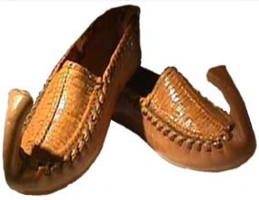
|
The Society of Folk Dance Historians (SFDH)
Opanke
[
Home |
About |
Encyclopedia | CLICK AN IMAGE TO ENLARGE |

|
 The "opanak," the celebrated leather moccasin-like peasant "shoe," is worn, or has been worn, by men, women, and children in all the Slavic countries as well as Greece, Romania, and Turkey. It has different names in different countries and languages, but the basic style is the same – the sole and the sides consist of one piece of leather. The decoration varies. Each area has developed its own style of decoration – the Greek "tsarouchi" has a large pom-pom at the toe; the Polish "kierpca" has a very attractive hand worked buckle; the Macedonian "opanak" has a modified "T-strap," and the Croatian "šestina" style uses red and blue strips of leather in its construction.
The "opanak," the celebrated leather moccasin-like peasant "shoe," is worn, or has been worn, by men, women, and children in all the Slavic countries as well as Greece, Romania, and Turkey. It has different names in different countries and languages, but the basic style is the same – the sole and the sides consist of one piece of leather. The decoration varies. Each area has developed its own style of decoration – the Greek "tsarouchi" has a large pom-pom at the toe; the Polish "kierpca" has a very attractive hand worked buckle; the Macedonian "opanak" has a modified "T-strap," and the Croatian "šestina" style uses red and blue strips of leather in its construction.
Yugoslavia seems to have the largest variety of "opanke." The styles with which most folk dancers are acquainted are Croatian, Macedonian, and Serbian. However, there is the Banat or Posavina style – usually all black with long straps that criss-cross and tie around the ankle; the south Serbian style that has a small hook (or horn or point – whatever you may want to call it); the modified Serbian style that has a rounded toe with no hook; the Montenegrin "kondure" of red leather; the Dalmatian style where string is used instead of the leather strips; and the Bosnian style, where blue, red, and white leather are used predominantly for decoration.
In Yugoslavia, "opanke" or "opinci," are made by an "opančar" (opanke maker). He usually uses natural colored leather, but other colors are not uncommon, for example, black or yellow. The construction varies. The Romanian "opinci" are rather simple. Other styles are more complex, requiring the use of wooden lasts and fine leather craftsmanship. The "opanak" seems to have reached its highest degree of sophistication in Šumadija. The weaving of the leather strips across the top is intricate and extremely attractive. "Opanke" form an important part of the folk costume. The Serb from this area is very proud to wear his national costume – from his "Šajać" or "Šubara" (two styles of caps) to his "Bridj pantalone" (trousers whose style was influenced by the riding pants of the French officers of the First World War) to his "opanke" with their turned-up toes (said to be of Turkish influence).
"Opanke" continue to be popular among folk dancers in Australia, Canada, Japan, the United States, and other countries. They give just the right feel and style to Balkan dances; they are comfortable, and they are always fashionable on the folk dance floor.
Bora, who died from a fall off a ladder in 2008, was the director of the Borino Kolo Ensemble and one of that special breed of special hand leather bookbinders and the leading "opančar" in the Los Angeles area.
DOCUMENT
- Bora Gajicki, an article.
Printed in Folk Dance Scene, November 1975.
This page © 2018 by Ron Houston.
Please do not copy any part of this page without including this copyright notice.
Please do not copy small portions out of context.
Please do not copy large portions without permission from Ron Houston.